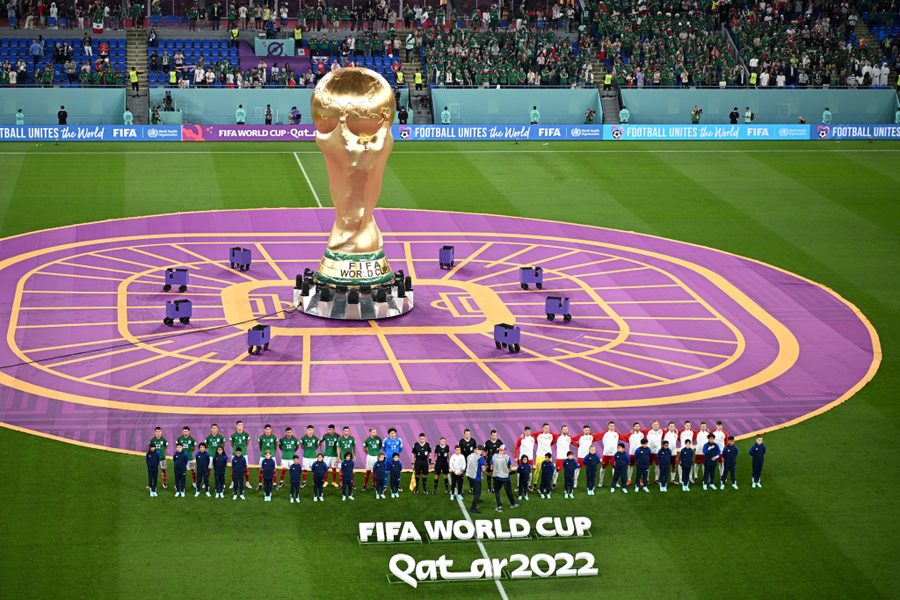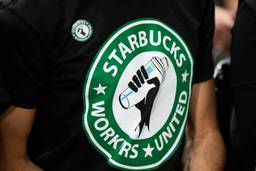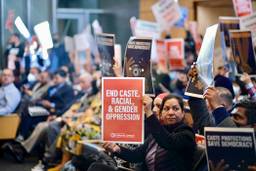This World Cup Is Brought to You By Abused Migrant Workers
Reports of widespread labor exploitation and safety hazards cast a dark shadow over the 2022 World Cup in Qatar.
Saurav Sarkar

In a full-throated defense of 2022 World Cup host nation Qatar, FIFA president Gianni Infantino said in a press conference on Saturday, “Today I feel Qatari, today I feel Arab, today I feel African, today I feel gay, today I feel disabled, today I feel a migrant worker…because I know what it means to be discriminated, to be bullied.”
Criticizing the West, and Europe in particular, for migration policies, corporate profiteering off of Gulf oil, and “what we Europeans have been doing for 3,000 years around the world,” Infantino tried to draw attention away from multiple controversies plaguing the 2022 World Cup.
FIFA, the governing body for world soccer, is expected to bring in $6.5 billion in revenue from this year’s World Cup, a 25% jump from the 2018 games. Infantino himself made $3.2 million in 2019 alone.
Meanwhile, over 6,500 workers have reportedly died in construction for the games since the World Cup was awarded in 2010 to Qatar, reflecting widespread safety hazards and labor abuses. Migrant laborers have been forced to pay billions of dollars in fees since 2011 to “recruitment agencies” in order to secure jobs at companies contracted to build the stadiums in which national teams will compete over the course of the tournament.
According to numerous human rights observers, workers have faced nonpayment of wages for up to a year, wage theft, severe mental health issues, 14-hour workdays, and a range of other abuses and poor conditions.
“Who in the world aside from billionaires can afford not being paid for 10 months or a year?” said Namrata Raju, the India Director for Equidem, a London-based human rights organization that has issued several critical reports on labor conditions in the Gulf.
Among the findings of Equidem’s most recent report, titled “If we complain, we are fired,” are reports of forced labor, workplace violence, health-and-safety issues and nationality-based discrimination. The report is based on conversations with about 1,000 workers conducted over the past three years, including 60 in-depth interviews.
One anonymous Kenyan worker cited in the report says, “Supervisors would hit us in front of other workers to pressure us to work faster and complete our work on time. This physical abuse was never addressed. You could report, but nothing would happen because the perpetrators were our supervisors.”
An unnamed Nepalese worker says, “In the summer season, it is very hot. The company provided rest shelters in some of the locations, but it is not enough space for all of us to take rest… Qatar nationals, Egyptian and Pakistani workers are provided air-conditioned rest areas by the company.” Temperatures can exceed 110 degrees between May and September in Qatar.
Conditions in Qatar’s leadup to the World Cup have been under fire for years since the country was awarded the games in 2010, and are part of a more general set of labor problems under the Gulf’s kafala system. This labor regime closely ties the low-wage migrant workers that the region’s economy depends on to their employers and leaves them with almost no voice and subject to massive abuses.
Human rights groups have reported that up to 10,000 migrant workers from South Asia, the Philippines, and other countries die in the Gulf each year.
After international pressure, the Qatari government has undertaken reforms since 2017 to mitigate the worst of the abuses, entering into an agreement with the International Labor Organization.
The reforms included a minimum wage increase, an end to requiring “exit permits” for migrant workers to leave Qatar, and the ability to change jobs without permission from the employer. The ILO reports mixed results, but abuses are reportedly continuing even as the World Cup gets underway.
Equidem’s Raju says the situation remains “dire” for migrant workers in the country. She describes the reforms as “lip service” because of a lack of enforcement and notes that labor unions remain illegal for migrant workers in the country. Strikes and protests by migrant workers are also illegal in Qatar.
Equidem is urging Qatar to set up a migrant workers’ center to allow workers an avenue to complain without being “terrified of some kind of punitive action,” in Raju’s words. The “first step [is] for workers to feel safe,” she says.
Qatar’s government has argued that the criticisms it has faced are the product of anti-Arab racism, with the country being targeted on issues ranging from the freedom of the press to LGBTQ+ rights.
At least one former World Cup migrant worker who In These Times spoke with agreed that Qatar has been selectively targeted, even though the anti-worker abuses are real.
Md. Emran Khan reported having worked 14-hour-days in Qatar as a technical assistant making and testing concrete for Qatari contractor Advance Construction Technology Services from 2016 to 2018.
“If it was in the U.S. or Europe, would the media be paying this much attention to worker abuses like these?” he asked in Bengali.
Khan now works for the Awaj Foundation in Bangladesh assisting prospective, current, and former migrants. He argues that Qatar is the best migration destination in the Gulf for South Asian migrants.
But Raju at Equidem argues that if Qatar were serious about racism, it would address the racism inherent in its labor system.
“I would ask them, if [they understand] what racism means, why do they have a two-tier labor system?” she asked. In the Gulf, different labor rules apply to migrants, who are predominantly African, South Asian and Filipino workers, leaving them in a much worse position than nationals and citizens of other Arab countries. For example, Qataris are allowed to form trade unions, while migrant workers are not.
Nationality-based discrimination and migrant worker abuses are a major issue in the region. Half of the total population of the Gulf and 85 percent of Qatar’s three million people are citizens of South Asian countries, the Philippines, and other Asian and African countries. This includes 98% of Qatar’s private sector workforce. The issue also has consequences for countries of origin, given the importance of remittance income for families of migrant workers.
Raju says, “We’re asking [FIFA] to compensate all of these workers [in Qatar]. So many workers have not been paid.”
A returned Nepali migrant worker pseudonymously titled “Hari” in a video released by Human Rights Watch describes how he worked in Lusail, Qatar’s second largest city, where, he says, “there wasn’t a single building anywhere” when he arrived.
“Now there are towers everywhere. We built those towers,” says Hari.
Equidem’s report also notes “a pattern of egregious worker rights abuses during the 2014 World Cup in Brazil and the 2018 World Cup in Russia.” For example, workers in Brazil worked 84-hour weeks and there were also thousands of evictions of working-class residents to make way for construction.
FIFA, Qatar’s government, and Qatar’s body in charge of its World Cup preparations, the Supreme Committee for Delivery & Legacy, did not respond to requests for comment.
Rolling Stone, which first covered Equidem’s report, received a statement from FIFA stating the soccer body would consult with its Qatari counterparts on the findings. The magazine also reported that Qatar’s government responded by touting its labor reforms, labor inspections, and awareness campaigns, resulting in a “year-on-year” reduction in labor offenses.
The Supreme Committee for Delivery & Legacy, meanwhile, said that it eliminates substandard contractors and subjects all contractors to due diligence. It blamed abuses on “bad-faith contractors.”
But an Indian construction worker quoted by Equidem who also worked in Lusail says, “If we protest, they threaten to cut our salaries or they fire us. Supervisors shout, abuse, and sometimes even beat workers. This is why no one protests. If I complain I will be abused, threatened with dismissal, and the duty will be made stricter for me.”







